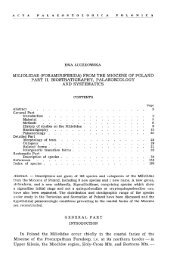The skull of Velociraptor - Acta Palaeontologica Polonica
The skull of Velociraptor - Acta Palaeontologica Polonica
The skull of Velociraptor - Acta Palaeontologica Polonica
Create successful ePaper yourself
Turn your PDF publications into a flip-book with our unique Google optimized e-Paper software.
202 Skull <strong>of</strong> <strong>Velociraptor</strong>: BARSBOLD & OSMOLSKA<br />
tinctly deviates in <strong>Velociraptor</strong>. This results in a different shape <strong>of</strong> the supratemporal<br />
fenestrae in both genera (see above). As noticed by Paul (1988), the dorsally directed<br />
frontal process <strong>of</strong> the postorbital is the character occurring both in <strong>Velociraptor</strong> and<br />
Deinonychus. Although the postorbital is unknown in Dromaeosaurus, the shape <strong>of</strong><br />
the frontal suggests (Currie 1995) that the frontal process <strong>of</strong> the postorbital was dor-<br />
sally directed, as in Deinonychus and <strong>Velociraptor</strong>. <strong>The</strong> axis <strong>of</strong> the frontal process is at<br />
a distinct angle to the axis <strong>of</strong> the jugal process in <strong>Velociraptor</strong>, this angle is much<br />
greater in Deinonychus. <strong>The</strong> pronounced dorsal direction <strong>of</strong> the frontal process is a<br />
character occurring in a few theropods (e.g., in oviraptorids, see Barsbold, Maryafiska,<br />
& Osm6lska in preparation), but seems extreme in the dromaeosaurids.<br />
<strong>The</strong> squamosal is generally similar in Deinonychus to that in <strong>Velociraptor</strong>, but<br />
shows a few differences: in Deinonychus, the prequadratic process is longer and more<br />
slender, the caudal process is more inclined ventrally, the occipital exposure <strong>of</strong> the<br />
squamosal above the paroccipital process is shallower, and the angle between the axes<br />
<strong>of</strong> the parietal and postorbital processes is only 60" (80" in <strong>Velociraptor</strong>). <strong>The</strong> squa-<br />
mosal in Dromaeosaurus has a much shorter caudal process than those <strong>of</strong> <strong>Velociraptor</strong><br />
and Deinonychus. <strong>The</strong> far caudal extension <strong>of</strong> this process produces in <strong>Velociraptor</strong><br />
(and probably also in Deinonychus) a shelf built <strong>of</strong> the squamosal and opisthotic,<br />
which extends behind, as well as laterally, to the cotyla for the quadrate head. It seems<br />
that this shelf was less extensive in Dromaeosaurus (Currie 1995: fig. la). <strong>The</strong><br />
prequadratic process in Dromaeosaurus is longer and narrower than in <strong>Velociraptor</strong>,<br />
and has a more extensive contact with the ascending process <strong>of</strong> the quadratojugal. In<br />
this respect, the prequadratic processes are similar in Dromaeosaurus and Deino-<br />
nychus. <strong>The</strong> distinctly quadriradiate shape <strong>of</strong> the dromaeosaurid squamosal is peculiar,<br />
due to its widely separate prequadratic and caudal processes, the axes <strong>of</strong> which are at<br />
about right angle to each other. In most theropods, these two processes are at an angle<br />
<strong>of</strong> less than 90°, or are subparallel. <strong>The</strong> prequadratic process <strong>of</strong> a similar shape occurs<br />
also in Troodon (Currie 1985), but, unlike dromaeosaurids, it does not contact the as-<br />
cending process <strong>of</strong> the quadratojugal (Russell & Dong 1994).<br />
<strong>The</strong> quadrate <strong>of</strong> Deinonychus is similar to that <strong>of</strong> <strong>Velociraptor</strong> (Dr. L.M. Witmer's<br />
personal communication 1999). In Dromaeosaurus, there is only a slight rostra1 exten-<br />
sion <strong>of</strong> the lateral edge <strong>of</strong> the shaft (Currie 1995: fig. 4b) instead <strong>of</strong> the large, triangular<br />
rostrolateral flange characteristic <strong>of</strong> <strong>Velociraptor</strong>. Colbert & Russell (1969) empha-<br />
sised that the mandibular articulation was well below the alveolar margin <strong>of</strong> the<br />
maxilla. This has been confirmed by Currie's reconstruction <strong>of</strong> the <strong>skull</strong> (1995: fig. la).<br />
<strong>The</strong> ventral projection <strong>of</strong> the mandibular articulation seems shallower in <strong>Velociraptor</strong>.<br />
<strong>The</strong> preserved portion <strong>of</strong> the left quadrate <strong>of</strong> Saurornitholestes shows a slight differ-<br />
ence in the more oblique course <strong>of</strong> the intercondylar groove. <strong>The</strong> troodontid quadrate<br />
is poorly known. According to the schematic illustration <strong>of</strong> Sinornithoides youngi pub-<br />
lished by Russell & Dong (1994: fig. 3), the rostrolateral flange is absent in this<br />
troodontid species. Unlike <strong>Velociraptor</strong>; the quadrate is pneumatic in troodontids (Cur-<br />
rie & Zhao 1994). Within the Dromaeosauridae, the quadratojugal, especially its as-<br />
cending process, is stoutest in Dromaeosaurus. In this genus, the ascending process<br />
has more extensive contacts with the quadrate process <strong>of</strong> the squamosal and the<br />
rostrolateral flange <strong>of</strong> the quadrate. In Deinonychus, the ascending process is about as

















